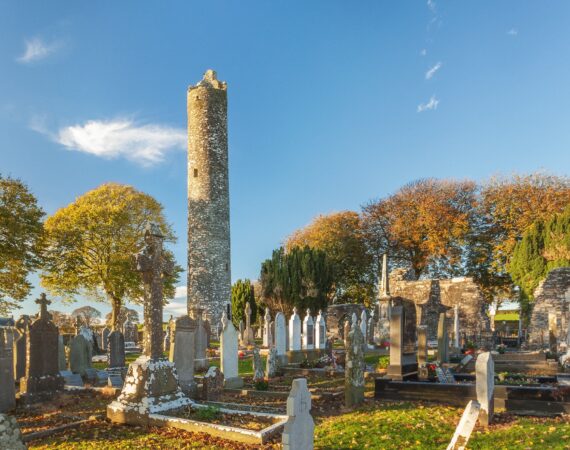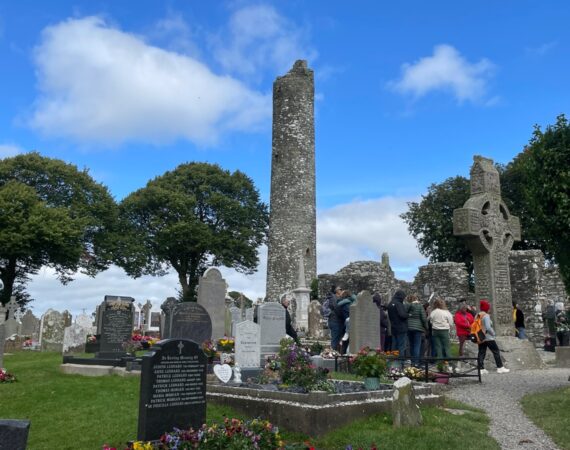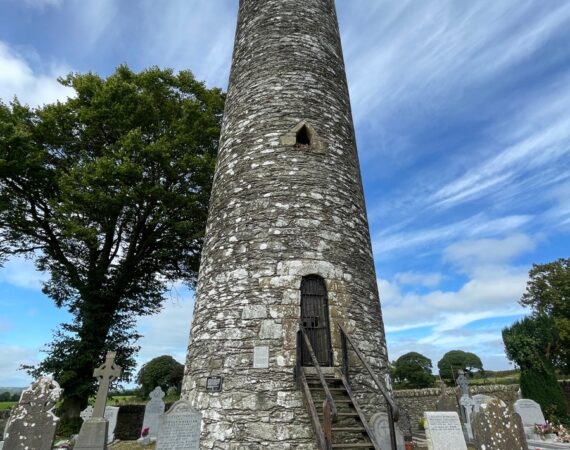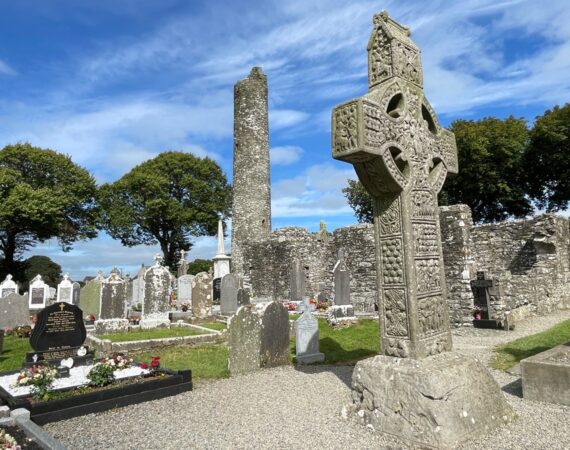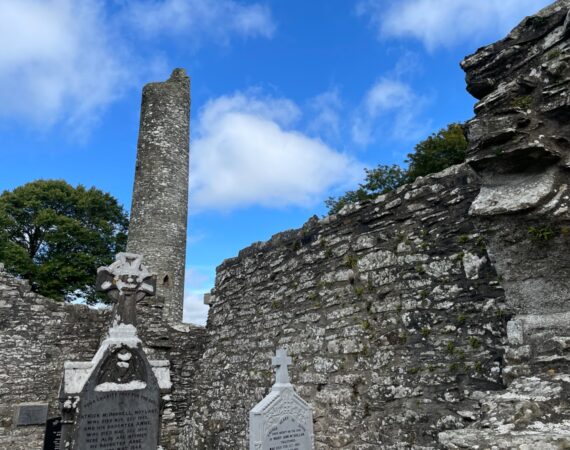Round tower, Monasterboice, Co. Louth
Ireland's tallest surviving round tower witnessed the devastating 1097 fire that consumed "books and many treasures," transforming this greywacke giant from a monastery's crown jewel into a monument to one of medieval Ireland's greatest cultural catastrophes.
Round tower, Monasterboice, Co. Louth
Standing at approximately 30.5 meters despite its ruined upper portion, this magnificent round tower ranks among Ireland’s tallest surviving examples and represents one of the finest specimens of early medieval Irish ecclesiastical architecture. Built from roughly coursed slabs and blocks of greywacke, it exemplifies the sophisticated engineering and craftsmanship achieved by 11th-century Irish builders.
Exceptional Height and Construction
The tower’s impressive height of 30.5 meters, even without its complete upper section, demonstrates the ambitious scale of construction at this major monastic center. Built from greywacke—a durable sedimentary rock—the tower showcases the medieval builders’ careful material selection for longevity and structural integrity. The roughly coursed construction technique created a robust structure capable of withstanding nearly a millennium of Irish weather.
The Tragic Fire of 1097
The tower’s history is marked by one of the most significant documented disasters in Irish round tower records. In 1097 AD, the annals record that the tower was burned “with its books and many treasures.” This devastating fire provides crucial evidence about round towers’ function as repositories for valuable manuscripts, religious artifacts, and monastic wealth—not merely bell towers as sometimes assumed.
The loss of books and treasures at Monasterboice represents a catastrophic blow to Irish learning and culture. As one of Ireland’s most important monastic centers, the tower likely housed irreplaceable manuscripts, possibly including works by the monastery’s famous scholars and illuminators. Whether the fire was accidental or deliberate remains unknown, but the cultural loss was immense.
Architectural Features and Dating
The round-headed doorway on the east side, positioned about 2 meters above present ground level, demonstrates sophisticated stonework. Constructed with moulded and carved sandstone blocks topped by a single large rounded arch stone, the entrance combines structural engineering with decorative artistry typical of 11th-century Irish ecclesiastical architecture.
The doorway’s elevated position reflects the standard round tower design for security—access required portable ladders that could be withdrawn in times of danger. This defensive capability proved crucial during the Viking raids that frequently threatened Irish monastic centers.
Interior Organization and Function
Like other Irish round towers, Monasterboice originally contained multiple wooden floors connected by internal ladders, creating a vertical series of storage and working spaces. The 1097 fire record confirms these towers served as secure repositories for the monastery’s most precious possessions—manuscripts, liturgical objects, relics, and other treasures that represented both spiritual and material wealth.
The upper bell floor, where bells would have hung to call the monastic community to prayer, has been missing since at least the 18th century. This loss is typical of Irish round towers, where the upper sections were often most vulnerable to weather damage, structural failure, or deliberate removal of building materials.
Historical and Cultural Context
Monasterboice was one of Ireland’s most significant monastic centers, famous for its high crosses, round tower, and scholarly achievements. The monastery produced some of the finest examples of Irish ecclesiastical art and served as a major center of learning during the golden age of Irish monasticism.
The round tower served multiple functions within this complex: as a bell tower calling monks to prayer, as a landmark visible for miles across the Louth countryside, as a symbol of the monastery’s importance, and crucially, as a secure strongroom for the community’s most valuable possessions.
Conservation and Heritage
The tower’s designation as National Monument No. 94 in State ownership ensures its preservation for future generations. This protection is particularly important given the tower’s exceptional height, architectural significance, and historical associations with one of Ireland’s most important early Christian sites.
The combination of impressive scale, historical documentation, and architectural sophistication makes Monasterboice’s round tower invaluable for understanding the role these structures played in medieval Irish society and the devastating impact of the cultural losses they sometimes suffered.
Good to Know
Height: Approximately 30.5 meters (despite ruined upper portion)
Materials: Roughly coursed greywacke slabs and blocks
Dating: 11th century
Historical tragedy: 1097 AD fire destroying "books and many treasures"
Doorway: Round-headed, east-facing, c. 2m above ground, carved sandstone
Cultural significance: Repository of manuscripts and monastic treasures at major Irish center of learning
Tags
Visitor Notes
Added by
Pete
Lennox Barrow, G. 1979 The round towers of Ireland: a study and gazetteer. Dublin. The Academy Press.

